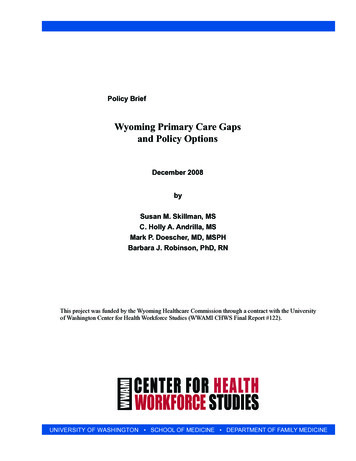
Transcription
Policy BriefWyoming Primary Care Gapsand Policy OptionsDecember 2008bySusan M. Skillman, MSC. Holly A. Andrilla, MSMark P. Doescher, MD, MSPHBarbara J. Robinson, PhD, RNThis project was funded by the Wyoming Healthcare Commission through a contract with the Universityof Washington Center for Health Workforce Studies (WWAMI CHWS Final Report #122).University of Washington School of Medicine Department of Family Medicine
About theWorkforce CenterThe WWAMI Center for Health Workforce Studies islocated at the University of Washington Departmentof Family Medicine. The major goals of the Centerare to conduct high-quality health workforceresearch; provide methodological expertise to local,state, regional, and national policy makers; build anaccessible knowledge base on workforce methodology,issues, and findings; and provide wide dissemination ofproject results in easily understood and practical formto facilitate appropriate state and federal workforcepolicies.The Center brings together researchers from medicine,nursing, dentistry, public health, the allied healthprofessions, pharmacy, and social work to performapplied research on the distribution, supply, andrequirements of health care providers, with emphasison state workforce issues in underserved rural andurban areas of the WWAMI region. Workforce issuesrelated to provider and patient diversity, providerclinical care and competence, and the cost andeffectiveness of practice in the rapidly changingmanaged care environment are emphasized.The WWAMI Center for Health Workforce Studiesand Rural Health Research Center Final Report Seriesis a means of distributing prepublication articles andother working papers to colleagues in the field. Yourcomments on these papers are welcome and should beaddressed directly to the authors. Questions about theWWAMI Center for Health Workforce Studies shouldbe addressed to:Mark P. Doescher, MD, MSPH, DirectorSusan Skillman, MS, Deputy DirectorUniversity of WashingtonDepartment of Family MedicineBox 354982Seattle, WA 98195-4982Phone: (206) 685-6679Fax: (206) 616-4768E-mail: chws@fammed.washington.eduWeb site: http://depts.washington.edu/uwchws/About the AuthorsSusan M. Skillman, MS, is the Deputy Director of the WWAMI Center for Health Workforce Studies andthe WWAMI Rural Health Research Center, Department of Family Medicine, University of Washington School ofMedicine.C. Holly A. Andrilla, MS, is a biostatistician for the WWAMI Center for Health Workforce Studies andthe WWAMI Rural Health Research Center, Department of Family Medicine, University of Washington Schoolof Medicine.Mark P. Doescher, MD, MSPH, is Director of the WWAMI Center for Health Workforce Studies and theWWAMI Rural Health Research Center, and is an Associate Professor in the Department of Family Medicine,University of Washington School of Medicine.Barbara J. Robinson, PhD, RN, is Project Director of the Wyoming Healthcare Commission and anAssociate Research Scientist at the University of Wyoming Center for Rural Health Research and Education.
Wyoming Primary Care Gapsand Policy OptionsSusan M. Skillman, MSC. Holly A. Andrilla, MSMark P. Doescher, MD, MSPHBarbara J. Robinson, PhD, RNExecutive Summary . . 3Introduction . . 5Wyoming’s Current Supply of Primary Care Providers . . 6The Future Supply of Primary Care Providers . . 9Providers’ Backgrounds, Education, and Sources of Support . . 12Key Survey Findings . . 16Other States’ Responses to Primary Care Needs . . 16Policy Options . . 17Executive SummaryNationally, primary care is in crisis and the situation isparticularly pressing in rural locations. This is occurringin spite of growing evidence that increasing the amountof primary care delivered to a population (in relation tospecialty care) improves health outcomes and lowershealth care costs. This report provides an overview ofprimary care providers (physicians, physician assistants,and nurse practitioners) within Wyoming, a rural frontierstate, and provides examples and policy options that couldbe employed to bolster the primary care workforce in thestate. The information is intended to provide Wyomingpolicymakers with greater understanding of their state’sprimary care workforce and tools to improve Wyomingresidents’ access to the primary care workforce.Wyoming’s Primary Care WorkforceThe Center for Health Workforce Studies at the Universityof Washington analyzed data from the WyomingHealthcare Commission’s 2006-2007 surveys of the state’shealth care and providers. The key findings were:Primary care supply is low in many counties. More than two-thirds of Wyoming’s counties (15 out of23) have fewer primary care providers than the nationalaverage. Twenty out of 23 Wyoming counties (87%)have fewer than the national average of primary carephysicians per 100,000 population. Nine counties (Campbell, Carbon, Goshen, Lincoln,Platte, Sweetwater, Uinta, Washakie, and Weston) appearto have major primary care provider shortages, withfewer than 75% of the national average of 126 providersper 100,000 population.Primary care provider supply may decline in the nextfew years. Within the next ten years both the physician andnurse practitioner supplies appear likely to decreasesignificantly because of age-related retirement.Non-physician clinicians make substantialcontributions to primary care supply. Non-physician clinicians (physician assistants and nursepractitioners) make up more than a third of the primarycare providers in Wyoming. Wyoming’s primary care workforce contains a higherproportion of physician assistants than the nationalaverage.Some primary care physicians noted challenges inmaking referrals and meeting malpractice insurancecosts. More than a third of the primary care physicians reportnot having sufficient access to ancillary and specialtyservices Thirteen percent have stopped providing some servicesdue to high malpractice insurance premiums.Many primary care providers come from Wyoming orother rural areas. A majority of primary care providers in Wyoming grewup in a rural area; a quarter to a third lived in Wyomingas a child; and a comparable portion obtained their initialpost-high school education within the state.Many primary care providers received their clinicaleducations in-state or from nearby states. Forty-six percent of Wyoming’s primary care nursepractitioners obtained their clinical education in
Wyoming, and the leading states for primary carephysician and physician assistant education are thenearby states of Nebraska, Utah, North Dakota, andWashington. One-fifth of Wyoming’s primary care physicianscompleted residencies in the state.Federal and state education assistance programs havebeen used by primary care providers. The Wyoming State Contract Medical Educationprogram (no longer active) contributed to the training ofmore than a fifth of the current primary care physicianworkforce. Other loan, scholarship and traineeship programs havebeen used by primary care providers, at varying rates.The 2006-2007 data collection effort provided muchvaluable information for assessing the primary careworkforce. Improved and ongoing workforce data collection andanalyses will further identify factors associated withrecruitment and retention of primary care providers, andtrack workforce trends over time.Other States’ Responses to PrimaryCare NeedsSeveral states have enacted legislation, or recommendedpolicy, to respond to the primary care workforce needs oftheir states. A Minnesota report recommends increasingenrollment in that state’s medical school, targetingstudents who are likely to practice primary care in ruralareas of the state; increasing rural training opportunities;increasing family medicine residency capacity in the state;expanding loan forgiveness programs for physicians whopractice rural primary care; and encouraging innovativepartnerships among regional health care organizations andthe academic health center to promote rural primary carepractice.A North Dakota report, focusing on the entire healthcare workforce, recommends increasing K-12 and highereducation students’ exposure to health care professions;promoting rural interdisciplinary health care educationprograms; seeking state support for recruitment strategies(such as tax incentives, loan repayment and scholarships)to attract health care professionals and educators to rurallocations; and fostering methods to create innovativework environments that will help attract and retainproviders (such as improving benefits packages, makingflexible work schedules, enhancing spouse employmentopportunities, promoting clinical faculty and otherprofessional enhancement opportunities).In Massachusetts, a recently passed “primary careworkforce” law includes a medical home demonstrationproject; formation of a Health Care Workforce Centerto help address workforce shortages; a loan forgivenessprogram for physicians and nurses who practice primarycare in medically underserved areas; an affordable housing pilot program for health care providers whopractice in underserved areas; increases in tuitionincentives for University of Massachusetts medicalstudents who agree to practice primary care in the statefor 4 years; and direction to the State Payment PolicyAdvisory Board to explore methods to improve paymentfor providers of primary care.Policy OptionsBased on the survey findings described in this report, andother states’ recommended approaches, the followingoptions are offered for consideration by Wyomingpolicymakers to help ensure an adequate supply of futureprimary care providers in Wyoming:1. Increase the overall number of Wyoming students inthe health sciences (the group most likely to selectpractice in their home state) by expanding collegeprogram capacity, Wyoming’s participation in theWWAMI medical school program, and implementingprograms that emphasize K-12 math and sciences skillbuilding and exposure to health science careers.2. Increase the number of health sciences students fromrural Wyoming as this group is the most likely topractice in rural locations.3. Expand opportunities for primary care and, inparticular, rural experiences during health professionseducation.4. Expand the number of family medicine residency slotsin Wyoming and create incentives for medical schoolgraduates from WWAMI and other neighboring statesto apply to them.5. Expand funding for loan forgiveness and physicianrecruitment for primary care and rural practice throughthe Wyoming Healthcare Professional Loan RepaymentProgram and the Wyoming Physician RecruitmentGrant Program.6. Work with federal, state, and private policymakers toimprove the reimbursement of primary care servicesthrough Medicaid, Medicare, and private insurance.7. Develop strategic regional partnerships with health caresystems, health plans and communities to address boththe recruitment AND retention needs of Wyoming’sprimary care workforce.The options presented above are not all-inclusive, butcould serve as a starting point for state-level discussion onthis pressing issue. In addition, ongoing and systematicworkforce data collection and analysis would allowstakeholders and policy makers to better understand theshort- and long-term factors related to ensuring healthcare providers enter and stay in primary care practicein Wyoming, and help to determine areas of the state ingreatest need for state assistance, such as through loanrepayment and physician recruitment programs.
Wyoming Primary Care Gapsand Policy OptionsSusan M. Skillman, MSC. Holly A. Andrilla, MSMark P. Doescher, MD, MSPHBarbara J. Robinson, PhD, RNIntroduction“ we know from various types of evidence thatthe more and the better primary care you have,the better are the health indicators in the area orin the country. In this country, states with higherprimary-care-physician-to-population ratios haveoverall better health, however you measure thehealth. And the impact on costs is equally striking.The more primary care we give relative to specialtycare, the lower the costs.”Barbara Starfield, MD, Professor of Health Policy andManagement, Johns Hopkins University1Nationally, primary care is in crisis and the situationis particularly urgent in rural areas. Policy makersseeking to strengthen the primary care workforceneed accurate information underpinning their efforts.This report provides an overview of primary careproviders within Wyoming, and provides examplesand policy options that could be employed to bolsterthe primary care workforce in the state. Primary careproviders comprise the majority of the rural health careworkforce. Access to primary care providers, however,is becoming increasingly difficult for Americans,and Wyoming is not immune to this problem. InWyoming, a rural frontier state, 19 out of 23 countiesare federally designated as having shortages of primarycare providers.2 A recent report commissioned by theWyoming Healthcare Commission found concernamong stakeholders that the availability of healthcareproviders is decreasing, while the state’s populationcontinued to grow.3 Retirement of primary careproviders is a significant source of this decrease, andit is expected to increase because nearly half (49%) ofWyoming’s physicians and 52% of its advanced nursepractitioners are age 51 or older.4While the total number of primary care providers in theUnited States, including the number per population,has increased in the past decades, the number ofprimary care physicians per population in rural areascontinues to lag behind urban areas. The number ofU.S. health care students who choose primary carefor their professional focus has declined, partiallydue to higher compensation for specialty care. Thiscompensation imbalance occurs despite growingevidence that primary care services such as preventivecare, coordination of care for the chronically ill, andmedical care continuity can improve health outcomesand contain costs.5Professional isolation, limited support for vacation andtime off, and difficulty finding professional activitiesfor spouses complicates the recruitment and retentionof rural primary care providers. Comparatively lowcompensation and rising costs, including liabilityinsurance, discourage health care providers fromchoosing primary care careers, which further reducesthe pool of potential providers who might practice inrural areas.The Institute of Medicine in 1996 describedprimary care as “ the provision of integrated,accessible health care services by clinicians whoare accountable for addressing a large majority ofpersonal health care needs, developing a sustainedpartnership with patients, and practicing in thecontext of family and community.”6 Primarymedical care is usually delivered by physicians,physician assistants and nurse practitioners withtraining in family medicine, internal medicine,preventive medicine and general pediatrics.
“At the heart of the decline in primary carelie dysfunctional payment systems, from the“gatekeeper” schemes of the 1990s to the currentvolume-driven, fee-for-service approaches leaving patients unhappy, physicians demoralized,a generation of U.S. medical students shunningcareers in the field, and access to care increasinglyproblematic—all contributing to an impendingnational health care crisis.”Allan H. Goroll, MD, Professor of Medicine,Harvard Medical School and MassachusettsGeneral Hospital, and chair of the MassachusettsCoalition for Primary Care Reform7The goal of this report is to provide information thatwill provide Wyoming policymakers with greaterunderstanding of their state’s primary care workforceand tools to improve Wyoming residents’ access to thisworkforce. Specifically, this Policy Brief examinesWyoming’s primary care workforce in order to: Assess the number and distribution of primary careproviders within the state, Examine some of the factors that may help retainthese providers and attract new ones to the state, and Provide options for policies that could be employedto help ensure an adequate future supply of primarycare providers in Wyoming.Wyoming’s CurrentSupply of Primary CareProviders Physicians (in family medicine, general practice,internal medicine, and pediatrics specialties). Physician assistants (in family medicine, internalmedicine and pediatrics specialties). Nurse practitioners (adult, family, geriatrics,pediatrics, and women’s health care specialties).How many primary careproviders are in Wyoming?Most of the primary care providers in Wyomingare physicians (65%), with nurse practitioners andphysician assistants comprising 19% and 15% ofthe workforce, respectively (see Figure 1). Thesethree provider types are not entirely interchangeable:physicians have the most extensive training and thelargest scope of practice. Nurse practitioners andphysician assistants (often called non-physicianclinicians) have shorter and less costly trainingrequirements, and have more restricted scopes ofpractice compared with physicians. In addition tovariation in scope of practice and therefore the serviceseach provider type can deliver to a community, anassessment of the size of the workforce should takeinto account whether or not the provider works fulltime or part-time in direct patient care.Primary care physicians are the most prevalent primarycare providers, with physician assistants and nursepractitioners, together, making up roughly one-thirdof the primary care providers in Wyoming. A similarsurvey in Washington state found that physicianassistants and nurse practitioners made up nearly aquarter of the generalist (primary care) providers inthe state, and performed about 21% of the generalistoutpatient visits in the state, with even highercontributions (25%) in rural areas of the state.8 Atpresent, the data to determine the number of servicesThe following statistics were generated by the Centerfor Health Workforce Studies at the University ofWashington through analyses of theWyoming Healthcare Commission’s2006-2007 surveys of health careproviders and facilities in the state.Figure 1: Primary Care Providers in WyomingThese surveys were carried out by theHealth Professions Tracking Center atNurse Practitionersthe University of Nebraska Medical111 (19%)Center.Who are Wyoming’sprimary careproviders?The definition of “primary care” variesacross the many settings in which it isapplied. For purposes of this report,the following self-reported specialtiesof Wyoming providers were includedin the definition of primary care. Physician Assistants86 (15%)Physicians374 (66%)
Where are primary careproviders in Wyoming?provided by non-physician providers in Wyoming arenot available, but could be collected in future surveysof the workforce. Based on numbers of providers, itcan be assumed that physician assistants and nursepractitioners are providing a significant portion ofprimary care services in Wyoming.The distribution of primary care physicians, physicianassistants and nurse practitioners further illustratesareas where access to primary care is problematic forWyoming’s citizens (Figure 2). Over two-thirds (65%)of Wyoming’s counties (15 of the 23 counties) havefewer providers than the national average and 57%(13 of the 23 counties) have fewer than the statewideaverage.The ratio of primary care providers to the state’spopulation is useful for comparison to other states,regions or the national average (see Tables 1 and 2).The numbers in Table 1 may somewhat overstatethe number of primary care physicians in Wyomingbecause it includes physicians who identified theirspecialty as “internal medicine”, which can includespecialized internists who may not be providingprimary care services. Future workforce surveys in thestate will obtain more detailed information to allowmore accurate counts of primary care providers.The number of primary care physicians per 100,000population is shown, by county, in Figure 3. Twentyout of 23 counties (87%) in the state have fewer thanthe national average of 90 primary care physicians per100,000 population. Eleven counties have fewer thanthe state average of 72 primary care physicians per100,000 population.Nine of Wyoming’s 23 counties (39%) appear to havemajor primary care provider shortages compared withthe national averages. Platte and Sweetwater countieshave less than half the national average number ofphysicians per 100,000 population, and less than halfthe national average for total primary care providersper 100,000 population. Campbell, Weston, Washakie,Uinta, Lincoln, Goshen and Carbon counties allhave between 50% and 75% of the national averageof primary care providers per 100,000 population.While the supply of primary care physicians in mostWyoming counties is lower than the national average,non-physician providers substantially contribute tothe primary care workforce. Three counties (Niobrara,Sheridan and Sublette) fall below the national averagefor primary care physicians per population (90 per100,000), but have more providers per population thanthe national average when non-physician clinicians areincluded (126 per100,000).While definitions of “primary care provider” may varydepending on the user and the quality of different datasources is variable, comparing Wyoming’s primarycare supply estimates with national averages providessome insights to Wyoming’s relative workforcesituation. The numbers in Table 2 come from a U.S.General Accounting Office report.5A comparison of Tables 1 and 2 shows Wyoming ashaving fewer physicians, more physician assistants andsomewhat fewer nurse practitioners providing primarycare per capita than the national average. Across allthree provider types, the statewide average for primarycare providers in Wyoming is approximately 110 per100,000 population compared with an estimated 126per 100,000 population for the nation overall.Table 1: Primary Care Providers per 100,000Population in WyomingProviders per 100,000 tionersTotal721621110Table 2: Primary Care Providers per 100,000Population in the United StatesProviders per 100,000 )NursePractitioners(2005)Total90828126Data sources for Table 2: U.S. GAO analysis of data from HRSA’s Area Resource File and organizations representingprimary care professionals.5
Figure 2: Primary Care Providers per 100,000 Population, by County,and Distribution of Primary Care Providers(physicians, physician assistants, and nurse practitioners)Figure 3: Primary Care Physicians per 100,000 Population, by County
The Future Supply ofPrimary Care ProvidersPrimary Care ProviderCharacteristicsThe three primary care provider types (physicians,physician assistants and nurse practitioners) sharesome background and practice characteristics, anddiffer on others (see Table 3). Slightly more than halfof nurse practitioners work full time, compared withmore than 70% of physicians and physician assistants.A larger proportion of physician assistants (71%)work in rural counties than do physicians (65%) andnurse practitioners (56%). On average physicianshave worked in Wyoming nearly 5 years longer thanphysician assistants, and only a year and a half longerthan nurse practitioners, consistent with the olderaverage age of both physicians and nurse practitioners.The supply of health care providers increases by newgraduates from professional education programs,in-migration, and the return of providers who havetemporarily left practice. Factors that decreaseprovider supply are retirement, death, out-migrationand other reasons providers discontinue practice. Thelargest reason for discontinuing practice is age-relatedretirement. As a result, health workforce plannerspay close attention to the age of the workforce. Aquarter or more of Wyoming’s primary care physiciansand nurse practitioners are currently older than age55, indicating that they are likely to retire within 10years (Figure 4). The primary care physician assistantworkforce is younger: just 14% are age 56 or older.Between 20%-25% of all three provider types work inmore than one location. Most, but not all, primary carephysicians have hospital privileges, and are on-call amedian of 36 hours per week. A quarter of primarycare physicians are on-call more than 61 hours perweek. Physician assistants and nurse practitioners takecall at much lower levels than physicians.Geographically, the aging of primary care workforceappears most significant in Teton, Sublette, Campbell,Natrona and Carbon counties (see Figures 5 and 6). Inthese five counties, more than 30% of the primary careworkforce is older than 55 years.Fewer than one-third of primary care physicians inWyoming are female, compared with more than 90%of nurse practitioners and half of physician assistants.More than one-fifth of physician assistants and nursepractitioners are non-white or are Hispanic, comparedwith 6% of physicians. More physicians, however,speak Spanish than do the other two primary careprovider types.Plans to retire or changepracticeMore than one-third of physicians indicated theyintended to retire within 5 years in three rural counties:Campbell (38.5%), Sheridan (30.0%) and Teton(42.9%). Statewide, more than 15% of primary carephysicians and 13% of nurse practitioners intend toretire from practice within 5 years (or by 2012). Lessthan 2% of physician assistants share those retirementplans (Figure 7). Estimates of years to retirement areless accurate the further away the survey respondentis from retiring, and retirement plans may change withfluctuations in the economy, but predictions for 5 yearsor fewer are likely to be reasonably reliable.Table 3: Primary Care Provider ractitionersWork full timeIn rural counties75.5%64.7%70.9%72.1%55.9%55.9%Average years in practice in Wyoming13.2Work in more than one location18.6%19.8%24.3%Have hospital privileges86.8%57.1%43.0%On-call hours per week: highest quartile61 hrs16 hrs13 hrsMedian weekly on-call hours36Female30.6%8.8050.0%11.6091.9%Speak Spanish5.9%1.2%1.8%Are Hispanic or non-white5.9%22.1%20.7%
Figure 4: Primary Care Provider Age100%Under 4040-55Over .1%20%21.3%24.5%13.5%10%0%PhysiciansPhysician AssistantsNurse PractitionersFigure 5: Percentage of Primary Care Providers (physicians, physicianassistants, and nurse practitioners) Over Age 55, by County10
Figure 6: Percentage of Primary Care Physicians Over Age 55, by CountyFigure 7: Primary Care Providers’ Plans for Retirement100%Within 5 yearsIn 6 or more ian AssistantsNurse Practitioners11
Issues Likely to Impact PrimaryCare AccessMore physicians (13%) indicated that malpracticeinsurance premiums had caused them to stop providingsome services than did physician assistants (3%) ornurse practitioners (3%) (see Table 4). This is probablybecause the costs of insurance coverage for someobstetrical services (that are usually not included inthe non-physician clinicians’ scope of practice) haveincreased dramatically in recent years.Providers’ Backgrounds,Education, and Sourcesof SupportThere is evidence that physicians who come fromrural areas are more likely to practice in rural areas.9In Wyoming, a majority of all primary care providerslived in rural areas in their childhoods (see Figure 8),including those working in rural counties.Where the state’s primary careproviders spent their youthOf the three primary care provider types, onlyphysicians were asked if they had sufficient access toneeded ancillary and specialty services. More than35% reported they lacked sufficient services.Between 27%-40% of Wyoming’s primary careproviders lived in Wyoming as a child, and providerswho work in rural counties show slightly higher ratesof this history (see Figure 9).Twenty to 25% of thestate’s primary carephysicians and physicianassistants attendedcollege in Wyoming, andmore than 35% of nursepractitioners obtainedtheir initial nursingeducation in the state(see Figure 10).Table 4: Primary Care Providers: Issues Related to AccessProviders ceasing to offer specific servicesdue to increased malpractice premiumsProviders who reported not having sufficientaccess to ancillary and specialty oners12.5%2.9%3.3%35.6%NA*NA** Question not included on questionnaire.Figure 8: Primary Care Providers Who Lived in a Rural Area as a Child100%90%StatewideRural %40%30%20%10%0%Physicians12Physician AssistantsNurse Practitioners
Figure 9: Primary Care Providers Who Lived in a Wyoming as a Child100%90%StatewideRural 0%28.3%20%10%0%PhysiciansPhysician AssistantsNurse PractitionersFigure 10: Primary Care Providers Who Attended College* in Wyoming100%StatewideRural .9%35.5%20.0%10%0%PhysiciansPhysician AssistantsNurse Practitioners* For nurse practitioners this refers to location of initial nursing education.13
State where primary careproviders received their clinicaleducationNo medical school or physician assistant educationprogram exists in Wyoming. Nearly 22% of primarycare physicians in the state reported they attendedmedical school in Nebraska, followed by Utah at 11%(see Table 5). The rest of the physicians attendedmedical school in a wide variety of other states.Wyoming’s physician assistants received their clinicaleducation in North Dakota (16%), Utah (12%),Washington (10%), Nebraska (10%), and a variety ofother states at smaller percentages.Physician assistants providing primary care inWyoming received their clinical education in manydifferent states, with no one state contributing morethan 20
Associate Research Scientist at the University of Wyoming Center for Rural Health Research and Education. . primary care providers (physicians, physician assistants, and nurse practitioners) within Wyoming, a rural frontier . housing pilot program for health care providers who practice in underserved areas; increases in tuition .
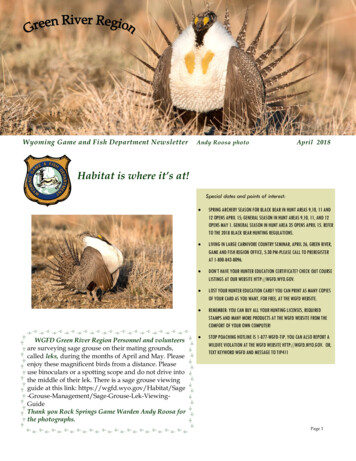
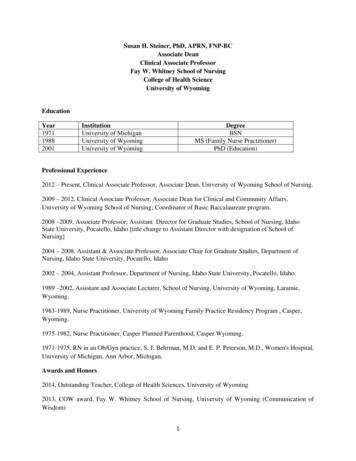
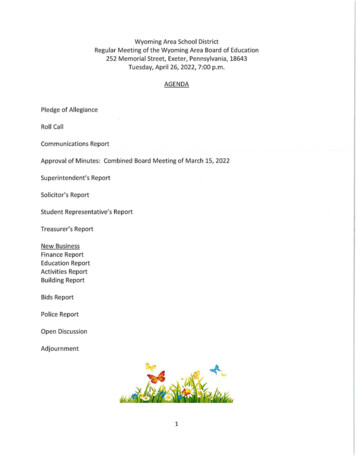

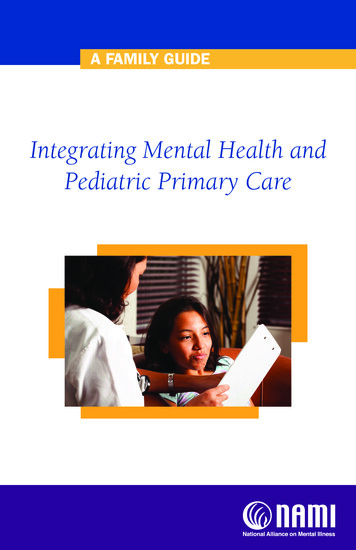


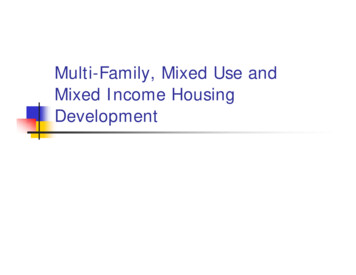

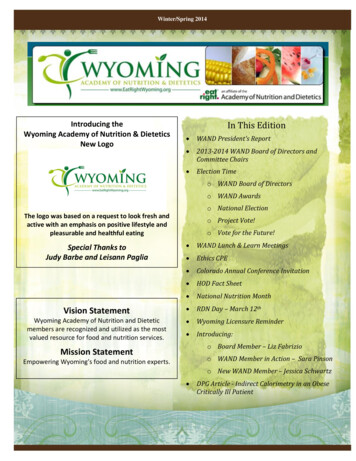
![Welcome [ wyomingworkforce ]](/img/14/program.jpg)